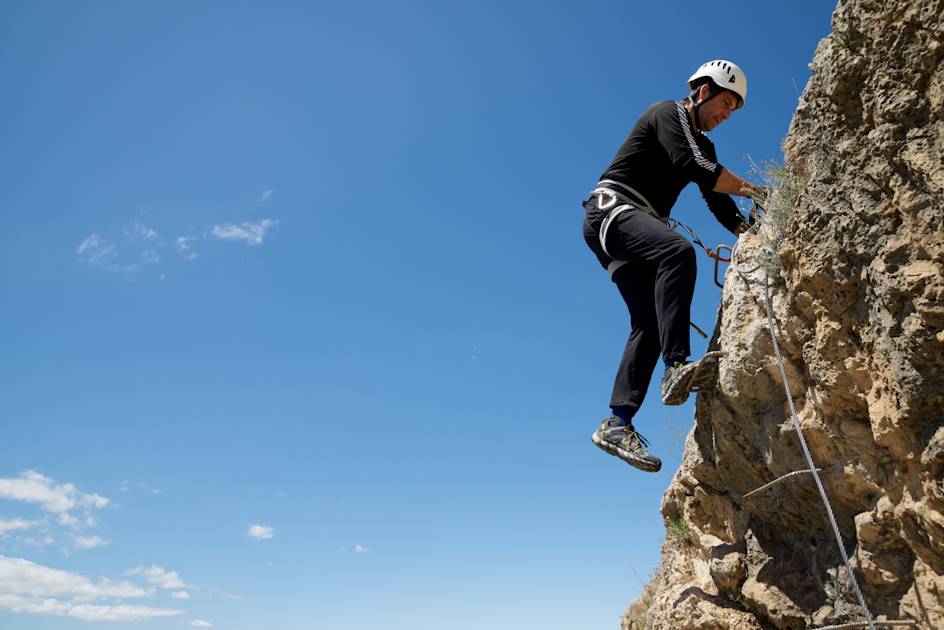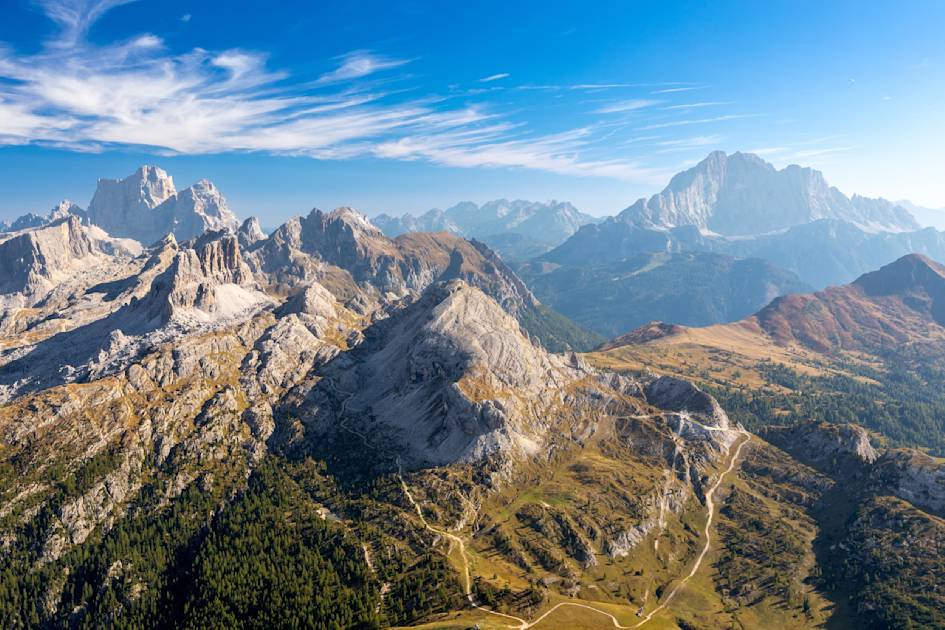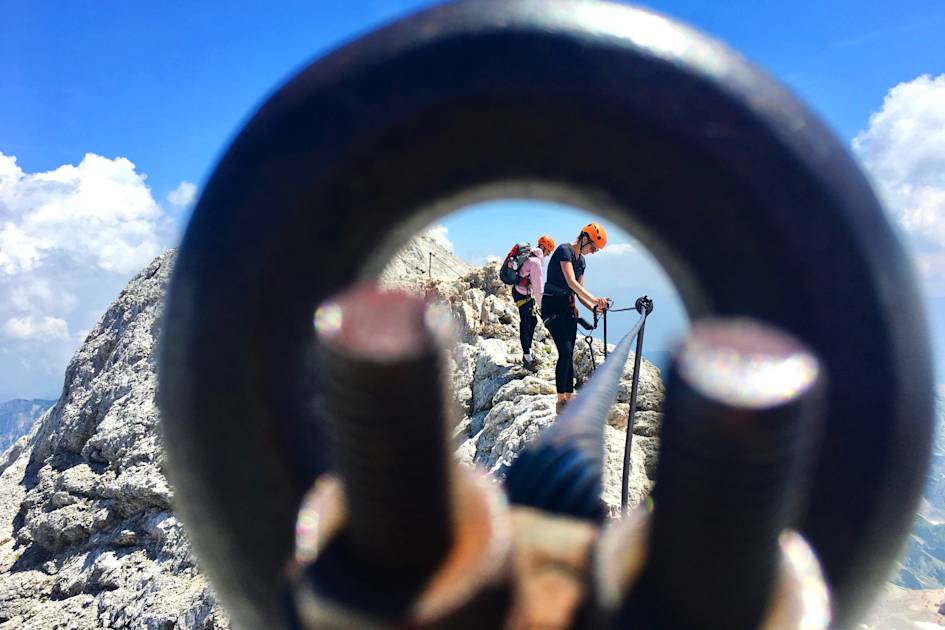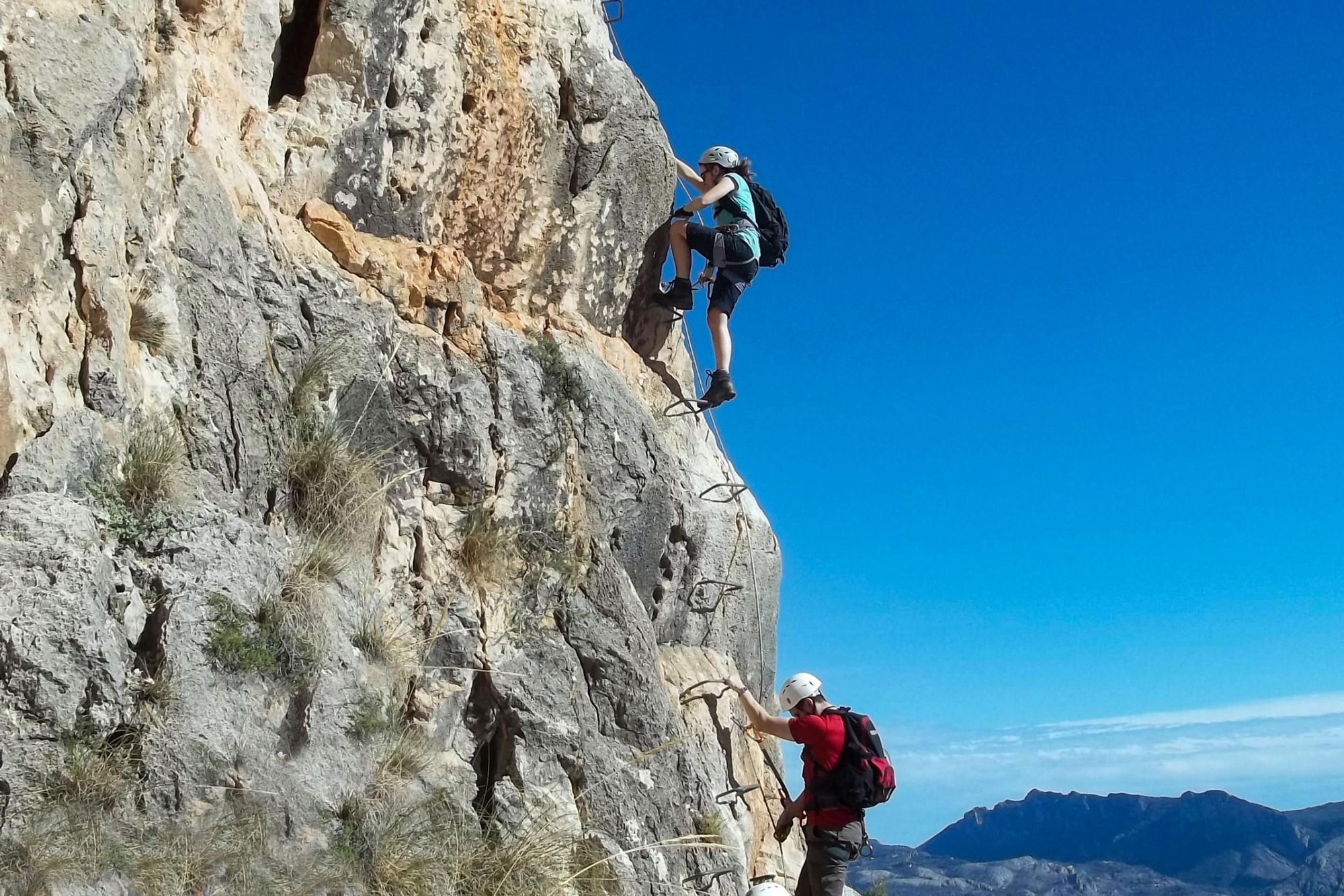Via ferrata means ‘iron path’, and it refers to a route through the mountains or along a cliff face equipped with rungs, ladders and even suspension bridges to assist climbers. It characteristically has a metal cable running alongside it; you'll wear a harness which you can clip onto this cable as you tackle the route.
To Jose Miguel Garcia, a climbing guide living in Alicante, via ferrata hits a sweet spot somewhere between walking, climbing and mountaineering.

“I like via ferrata because they’re fast," he says. "They give you access to summits and you don’t follow a track; there’s always cables and iron rungs to point you in the right direction. Walking to the summit is great, but if you walk along the slightly spicy way to the summit, it’s much more rewarding.
“The other cool thing about via ferrata is that it removes all the danger from climbing, and simplifies the amount of skills and ropework you need. That's why people love it. It's a simple system, a kid-friendly security system; you click in and you’ve got the thrills of heights, or going along a bridge.”

Via ferrata were first established in the Dolomites during the First World War.
“The Dolomites has a limestone landscape with lots of pinnacles and ridges. The Italian and Austrian troops had to move from one side to the other with heavy equipment. So they put up cables and rungs to help pull themselves along,” Jose explains. “More recently, via ferratas have become a leisure activity. It started in France and spread out across Europe. There aren’t many in the UK, probably because of the landscape; you need mountains, or abandoned quarries.”
Jose started climbing at the age of 16, which means, he tells us, that he’s been “in the game” for 40 years. He gave us his top tips for tackling via ferratas – and explains why he thinks you should try it for yourself.
How to do Via Ferrata: Top Tips
1. Learn Basic Skills With a Guide

Jose recommends first trying out a via ferrata with a guide while you’re still a beginner. He's seen a lot of people go unguided because they think knowing how to move forward along the via ferrata is sufficient.
“Too many people don't know how to fasten them properly in case of a fall,” he says. “People don’t always know how to fix the helmet properly, which is really important.”

“Let’s say you have a mild fall on a via ferrata; you twist your ankle and don’t want to continue. You can always abseil down or escape the route. But you need to know how to abseil, or how to clip onto a safe rope. You need to have some rescue skills, some ropework techniques, basic stuff. So learn with a guide.
“If you go with a guide, they have a plan B and a plan C. If you go as an individual, do you have a plan B? People are very good on the ascent, but then there’s a descent and they realise all of a sudden that they don't like it. As a guide, I can put them on the rope and then they feel safe. You don't know you need a guide until you need them.”
2. Choose the Right Via Ferrata for Your Skill Level

There are several different systems of grading via ferratas, but two of the most commonly used are the Hülser and Schall scales. The Schall uses a difficulty scale ranging from A to F (‘A’ being the least difficult), while the Hülser uses a numbered difficulty rating.
“They're normally classified from K1 to K6. ‘K’ is the symbol for iron,” Jose says. “K1 and K2 are via ferratas the public can do, whereas K3 will give you more arm stress.”

“Classifying things is always hard. You know, what’s a difficult mountain bike ride? Is it 10 kilometres? Or is it 50 kilometres? Those are relative depending on your strength and general physical condition. I might say via ferrata is ‘easy’ but you still need a head for heights and some arm strength; even if you’re stepping on steps you need to support your body.”
In other words, what’s ‘easy’ is relative. On Jose’s introduction to via ferrata course, people climb via ferratas with sections of different difficulty levels. While he and other guides can assess their clients’ skill levels, it’s also important to assess yourself, as you’re best placed to understand your own limitations.
“It's fine if you're getting tired, getting a bit pumped, getting your heart rate up and being challenged,” he says. “But if you’re totally physically and mentally exhausted after one hour it’s probably too big for you – you are going to get thrashed and then it's no fun. That’s when you’re going to have incidents.”
3. Wait for Good Weather

You should tackle via ferratas only in dry conditions, says Jose.
“Lightening is dangerous, right? If it catches a cable and fries people,” he explains. “In some places, hundreds of people climb every day and the rock is polished smooth, so it gets slippery in the rain. If it’s wet and thundery, the approach will be challenging. And the descents - my god! The descents. Some in the Dolomites are really scary in winter; they have landslips because of the snow.”
He recommends coming to Alicante, where he lives, a mountainous area known for its via ferratas.
“Alicante is the second most mountainous province in Spain so we’ve got lots of rock faces. We’ve got the best ferratas, they’re very accessible,” he says. “South of Alicante is classified as one of the driest places in Europe. People will be able to do via ferratas on limestone in dry conditions.”
4. Don’t Panic, They’re Much Safer than You Think

Just how dangerous are via ferrata? Via ferratas themselves are very safe, says Jose – they become unsafe when they’re misused.
“In Spain and in the rest of Europe there are regulations. The via ferratas I take groups to have only been installed by certified companies, with proper chemical glues,” he says. “These companies have to maintain them. Normally they have an agreement with the local town hall, and have to check them every year.”
Jose also points out that on a via ferrata you’ll be wearing safety gear and equipment, which will keep you safe. “A helmet, a harness with two lanyards – like a rope that stretches a bit – with carabiners on the end,” he says. “You always clip to the metal cable with two lanyards, but every time you get to a junction point, you unclip one and clip into the next section, unclip and clip.
The via ferratas I take groups to have only been installed by certified companies, with proper chemical glues
“If you fall, you’re going to be stopped by your own lanyard. It has what we call a ‘disipador’ or an energy absorber. It's a system that cracks open, so you don’t get a heavy whack on your back.”

However, just because something is safe, doesn’t mean it feels safe, especially if ‘something’ happens to be a metal cable embedded in a vertiginous cliff face, or a rickety suspension bridge between two limestone pinnacles.
“When people panic on a via ferrata we do breathing exercises, try and get our heart rate down,” Jose says. “Then I help people analyse the reality of the situation. I show them they’re safely clipped, that they won’t fall. I tell them they might be out of their comfort zone but they’ve got the physical strength to do this.”
5. Make Sure You Train Beforehand

If Jose has one top tip for tackling your via ferrata, it’s to make sure that you’ve adequately trained for it.
“Take it seriously. Do some training,” he says. “Some people think because they’re paying a guide he’s going to pull the rope and bring them up to the summit like a sack of potatoes. Nah man, I'm not gonna pull your body up the rope. You need to pull yourself up the mountain by yourself.
Some people think because they’re paying a guide he’s going to pull the rope and bring them up to the summit like a sack of potatoes
“It’s a good experience but you need to come here with your homework done. Take responsibility for your own success. Book a trip a few months in advance. Then spend the next few months going to the gym, and do a few sessions at an indoor climbing wall to practice the techniques.
“You're gonna get extra strength, you're gonna build confidence. And when you arrive you’ll be much happier. There’s less chance of checking out or having panic. Sure, it’s a holiday, not a competition. But active holidays are about enjoyment, with a commitment.”
Inspired? Check out our Intro to Rock Climbing and Via Ferrata in Spain, designed and guided by Jose himself.



